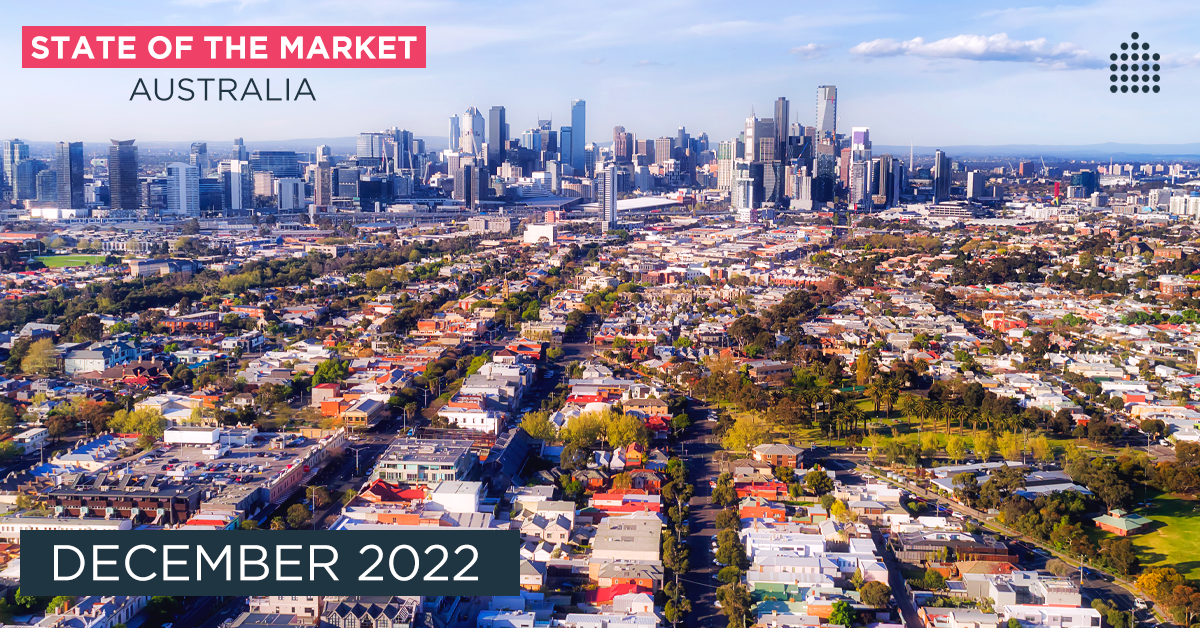Australia’s housing market continued to post falls in the month of November, although the pace of decline is steadily decelerating. The Reserve Bank of Australia (RBA) has signalled further rate hikes ahead, however, which would delay any recovery in the property sector.
The current state of the market
Nationwide housing prices continued to fall in November, extending a run of declines that first commenced in May.
CoreLogic’s national Home Value Index (HVI) fell 1.0%* in November compared to the preceding month, for the seventh consecutive month of contraction.
The pace of descent continued to ease however, with the 1.0% fall in November marking the smallest monthly decline since June. On-month declines in the HVI have moderated steadily since dropping 1.6% in August.
Tim Lawless, CoreLogic’s research director, said the softening pace of decline is largely thanks to the housing markets of Sydney and Melbourne.
“Three months ago, Sydney housing values were falling at the monthly rate of -2.3%. That has now reduced by a full percentage point to a decline of -1.3% in November,” he said.
“In July, Melbourne home values were down -1.5% over the month, with the monthly decline almost halving last month to -0.8%,” he said.
The CoreLogic HVI is now 7.0% beneath the peak value posted in April 2022, which arrived in the wake of a 28.6% surge during Australia’s Covid-era housing boom.
Reserve Bank of Australia signals further tightening ahead
It could still be too soon for the Australian property sector to find reassurance in the steadily easing pace of nationwide home price declines.
The RBA took markets by surprise on 6 December, by committing to hawkish monetary policy beyond the end of the year.
While its 25 basis point rate hike was in line with expectations, the move nonetheless lifted the official cash rate to 3.10%, for its highest level in more than a decade.
More significant was the RBA’s official statement that pointed to further rate hikes after the start of 2023. Many observers had previously hoped for the RBA’s run of hawkish monetary policy to conclude by the end of 2022.
“The Board expects to increase rates further over the period ahead,” RBA governor Philip Lowe said in the statement. “The Board remains resolute in its determination to return inflation to target and will do what is necessary to achieve that.”
Any further rate hikes in 2023 may continue to put pressure on the Australian property market, by keeping the cost of borrowing high.
Property fundamentals still undeniably strong
Despite the delay in a market recovery due to hawkish monetary policy, we believe the fundamentals of the Australian property market still remain strong over the medium and long-term.
With not much change in the property market other than further interest rate rises but at a slower pace, CrowdProperty’s Daniel He said the question is whether inflation has peaked.
“If it has, then there might be less pressure for further rate rises,” Daniel said.
“With predictions of rate rises up to 3.75% cash rate according to the RBA, this could perhaps present a bottoming trend and opportunity for real estate to rise from this point onward.”
CrowdProperty CEO and co-founder David Ingram said the cost of capital is normalising.
“Only a small percentage of all Australian homes are mortgaged with a fixed rate, with about 30% of ownership with no mortgage” Ingram said.
“While it could be a shock to those coming off fixed rates — especially if they have only ever borrowed in the low rate environment — overall, the housing market might face less of a fall from the ‘cliff’ that many are talking of.
“Traditionally we see a 20% increase in sales as we come into spring. Given the market fundamentals, it’s not surprising that we haven’t seen any material increase in listings this year. At CrowdProperty we’re seeing improving conditions for buyers — there are opportunities for small-scale developers with less competition in the market from home buyers meaning they have been able to negotiate better settlement terms, allowing time for proper due diligence to inform their feasibility studies.”
Rob Flux, developer and educator from the Property Developer Network, said that the extension of hawkish monetary policy could delay a recovery in the property market until well into next year.
“My personal opinion is that the end of Q1 will likely be the bottom, or at least the start of the plateau,” he said. “It will probably sit there for a good six months or so before we start to see things start to turn around.”
“The underlying structural fundamentals are extremely strong - the biggest driver is population growth because of international migration,” Flux said.
Flux further points out that there is likely to be an acute shortfall in supply moving ahead as a result of the Covid pandemic.
“Covid meant a whole bunch of development approvals never happened, so there’s a large amount of potential supply that never went into the system.”
For this reason, Flux sees opportunities for investors in the first quarter, should RBA rate hikes keep pressure on the market.
“The key area of opportunity is property prices slowing hard in the first quarter of next year,” Flux said.
CrowdProperty provides fast, simple and transparent property project finance for property professionals, learn more.
*https://www.corelogic.com.au/news-research/news/2022/corelogic-home-value-index-national-dwelling-values-fell-1.0-in-november,-the-smallest-monthly-decline-since-june
Contributors
Rob Flux is the owner and founder of Property Developer Network, the largest national network of novice developers and renovators in Australia with a combined community of over 15,000 people.
